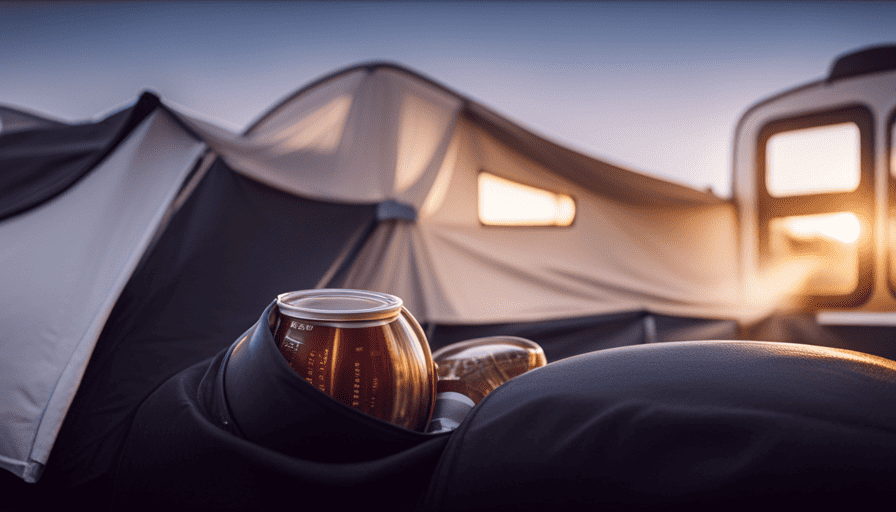Do you find yourself feeling drained from the unpredictable ups and downs of your camper? Are you in need of a reliable and safe camping experience? Well, fellow adventurers, I have some exciting news to share with you.
In this article, I will guide you through the art of making your camper more stable. Get ready to say goodbye to those wobbly nights and hello to a steady and enjoyable camping experience.
But how do we achieve this feat, you ask? Fear not, for I have done extensive research and compiled a comprehensive list of techniques that will transform your camper into a fortress of stability. From leveling your camper to reinforcing its structure, we will leave no stone unturned in our quest for stability.
So, buckle up and prepare to dive deep into the world of camper stabilization. By the end of this article, you will be equipped with the knowledge and tools to make your camper as stable as can be.
Let’s embark on this journey together and create a camping experience that is as safe as it is enjoyable.
Key Takeaways
- Assess the current stability of the camper by evaluating its structure, suspension system, tires, and weight distribution.
- Stabilize the camper by using leveling jacks, adjusting them as needed, and checking the levelness with a leveling tool.
- Enhance stability by installing stabilizer bars or sway control systems, upgrading to heavy-duty shocks, and reinforcing the camper’s structure.
- Improve aerodynamics and reduce wind resistance by installing a wind deflector, adding side skirts, and regularly maintaining the camper’s exterior.
Assess Your Current Level of Stability
Now, take a moment to assess your camper’s current level of stability, and consider how you can make it even more secure and reliable. Assessing stability is crucial to ensure a safe and comfortable camping experience.
Start by evaluating the structure of your camper. Look for any signs of wear and tear, such as cracks or loose fittings, that could compromise stability. Check the suspension system for any signs of damage or excessive wear. Inspect the tires to ensure they’re in good condition and properly inflated.
Next, evaluate the weight distribution inside your camper. Uneven weight distribution can lead to instability. Make sure heavy items are stored low and centered, as this will help keep the camper balanced. Consider investing in stabilizing equipment like stabilizer jacks or leveling blocks, which can provide additional support and minimize movement.
Furthermore, assess the overall condition of your camper’s foundation. Look for any signs of sagging or weakness in the frame. Reinforce weak areas if necessary, and consider upgrading to a stronger frame if you frequently encounter stability issues.
By assessing stability and evaluating the structure of your camper, you can identify areas that need improvement and take steps to enhance its stability. Now, let’s move on to the next section about leveling your camper.
Leveling Your Camper
To ensure a level surface, it’s crucial to properly level your camper for enhanced stability and a more enjoyable camping experience. Here are five steps to help you improve stability by adjusting the leveling jacks:
-
Position your camper on a flat surface: Look for a level area where the camper can be parked. This will provide a stable foundation for the leveling process.
-
Extend the leveling jacks: Start by extending the jacks on each corner of the camper. Gradually lower them until they make contact with the ground.
-
Use a leveling tool: To determine if your camper is level, use a leveling tool such as a bubble level or smartphone app. Place it on a countertop or floor to check the levelness from side to side and front to back.
-
Adjust the jacks as needed: If the bubble is off-center, adjust the jacks accordingly. Raise or lower them to achieve a level position.
-
Check the stability: Once the camper is leveled, check the stability by gently rocking it from side to side. If it feels stable, you’ve successfully leveled your camper.
Now that your camper is level, let’s move on to the next section about how to stabilize your camper’s suspension for an even more stable camping experience.
Stabilize Your Camper’s Suspension
When it comes to stabilizing your camper’s suspension, there are a few key points to consider. First, installing stabilizer bars or sway control systems can greatly improve the overall stability of your camper while towing. These systems work by reducing the side-to-side movement and sway that can occur while driving.
Additionally, upgrading to heavy-duty shocks can help to minimize any bouncing or jolting that may occur while on the road, providing a smoother and more controlled ride.
Install Stabilizer Bars or Sway Control Systems
By adding stabilizer bars or sway control systems, you’ll give your camper the stability it needs for a smoother ride. Stabilizer bars, also known as anti-sway bars, are designed to minimize body roll during turns, ensuring that your camper stays level and balanced. These bars connect the suspension on both sides of the camper, reducing the side-to-side movement that can lead to swaying. Sway control systems, on the other hand, use additional components such as friction or hydraulic devices to actively counteract any sway that may occur. These systems are particularly effective when towing larger or heavier campers.
To illustrate the benefits of stabilizer bars and the effectiveness of sway control systems, consider the following table:
| Stabilizer Bar Benefits | Sway Control Effectiveness |
|---|---|
| Minimizes body roll | Actively counteracts sway |
| Enhances stability | Provides a smoother ride |
| Improves handling | Increases towing safety |
| Reduces driver fatigue | Ensures optimal control |
By incorporating stabilizer bars or sway control systems, you can significantly improve the stability and control of your camper. However, if you’re looking for an even greater upgrade, consider upgrading to heavy-duty shocks for enhanced performance and durability.
Upgrade to Heavy-Duty Shocks
Consider upgrading to heavy-duty shocks for a heightened level of performance and durability in your camper’s suspension system. When it comes to upgrade options, heavy-duty shocks are a worthwhile investment. These shocks are specifically designed to handle the added weight and demands of a camper, providing improved stability and control while towing.
The benefits of heavy-duty shocks include enhanced shock absorption, reduced body roll, and minimized bouncing, resulting in a smoother and more comfortable ride. Moreover, these shocks help to distribute weight evenly across all four corners of the camper, preventing excessive strain on the suspension components.
By upgrading to heavy-duty shocks, you can optimize your camper’s suspension system and ensure a safer and more enjoyable travel experience.
Moving on to reinforcing your camper’s structure…
Reinforce Your Camper’s Structure
To make your camper more stable, strengthen its foundation like the roots of a mighty oak tree. One way to reinforce your camper’s structure is by reinforcing its flooring. This can be done by adding additional support beams or using thicker, more durable materials. By doing so, you can prevent the floor from sagging or flexing under the weight of the camper and its occupants.
Another area that can benefit from reinforcement is the camper’s walls. Adding additional bracing or using stronger materials can help to prevent the walls from bowing or flexing, especially during rough road conditions or strong winds. By reinforcing both the flooring and walls, you can ensure that your camper remains sturdy and stable, even in challenging environments.
Moving on to the next section about reducing wind resistance, it is important to consider how the design of your camper can affect its stability.
Reduce Wind Resistance
Feel the wind glide effortlessly past your camper as you find ways to reduce wind resistance. Improving the aerodynamics of your camper is essential in reducing drag and increasing stability on the road.
One effective way to achieve this is by installing a wind deflector on the front of your camper. This simple addition redirects the airflow over the top, reducing the amount of wind that hits the front of the camper.
Additionally, consider adding side skirts along the bottom of your camper. These panels help to smooth the airflow and prevent air from getting trapped underneath, which can cause instability.
Another way to reduce wind resistance is by keeping your camper’s exterior clean and smooth. Remove any unnecessary accessories or racks that create turbulence. Make sure that all seams, joints, and edges are sealed properly to avoid air leakage. Consider investing in a camper cover that fits snugly and reduces wind drag. Additionally, ensure that your tires are properly inflated to reduce rolling resistance.
By implementing these measures, you can significantly improve the aerodynamics of your camper and reduce wind resistance, making it more stable on the road. With a streamlined exterior, your camper will be ready to tackle the next step of securing its exterior, ensuring a safe and enjoyable journey.
Secure Your Camper’s Exterior
When it comes to securing your camper’s exterior, there are a couple of key points to keep in mind. First, it’s important to regularly check and tighten all external connections to ensure that everything is secure and in place. This includes things like the roof rack, awning, and any other attachments.
Secondly, using wind-resistant tie-downs or anchors can provide added stability and prevent your camper from being easily moved by strong winds. These tie-downs or anchors should be placed strategically to distribute the force of the wind and keep your camper firmly in place.
Check and Tighten All External Connections
Inspect all external connections on your camper, making sure to tighten them to ensure maximum stability. To improve stability and prevent accidents, it’s crucial to check and tighten all external connections regularly.
Start by examining the connection points between the camper and the tow vehicle, such as the hitch receiver and safety chains. Ensure that they’re securely attached and that there’s no excessive play or movement.
Next, inspect the connections between the camper and its leveling jacks, stabilizer bars, and sway control devices. Make sure these are tightened properly to minimize any wobbling or swaying while on the road.
Additionally, examine the exterior doors, windows, and awnings, ensuring that they’re securely fastened and closed. By addressing loose or weak connections, you can significantly enhance the stability of your camper.
Moving forward, let’s discuss the importance of using wind-resistant tie-downs or anchors.
Use Wind-Resistant Tie-Downs or Anchors
Using wind-resistant tie-downs or anchors is like securing your camper with strong ropes, providing an extra layer of protection against strong gusts of wind that can potentially topple or damage your camper. These tie-downs and anchors are specifically designed to withstand high winds and keep your camper stable and secure.
Here are three types of wind-resistant tie-downs or anchor systems that you can consider for your camper:
-
Screw-in Anchors: These are heavy-duty anchors that can be screwed into the ground and provide a strong hold.
-
Strap Tie-Downs: These are adjustable straps that can be attached to your camper and anchored to the ground using stakes or weights.
-
Ball Bungee Cords: These cords have a ball on one end and can be stretched to secure your camper by attaching them to anchor points.
By using wind-resistant tie-downs or anchors, you can ensure that your camper stays stable even in high winds.
Now, let’s explore how you can improve your camper’s interior layout.
Improve Your Camper’s Interior Layout
Revamp your camper’s interior layout to create a cozy and functional space that will make you never want to leave. When it comes to improving your camper’s interior, it’s all about maximizing space and improving storage. By making strategic changes to your layout, you can create a more organized and efficient living space.
To help you visualize the possibilities, take a look at the table below showcasing some ideas for improving your camper’s interior layout:
| Column 1 | Column 2 |
|---|---|
| Install wall-mounted | Use collapsible storage |
| shelves for added | containers to maximize |
| storage space | space efficiency |
| Reconfigure seating | Utilize under-bed |
| area to create | storage for bulky items |
| a multifunctional | such as camping gear |
| space |
By incorporating these ideas, you can transform your camper’s interior into a practical and comfortable living space. Utilizing wall-mounted shelves will provide additional storage space for items such as books, kitchenware, and personal belongings. Reconfiguring the seating area can create a multifunctional space that can be used for dining, working, and lounging.
Improving your camper’s interior layout is an essential step in creating a stable and enjoyable living environment. By maximizing space and improving storage, you can create a functional and cozy space that will enhance your camping experience. Consider these changes as you move on to the next section, where we will discuss aftermarket stabilization products.
Consider Aftermarket Stabilization Products
When it comes to improving the stability of your camper’s interior layout, one option to consider is exploring aftermarket stabilization products. These products can provide additional support and stability to your camper, making it more secure and comfortable.
Another option is to research camper-specific upgrades or modifications that can enhance the stability of your camper’s interior layout. By exploring these options, you can ensure that your camper is stable and secure, providing a more enjoyable camping experience.
Explore Stabilizing Systems or Devices
One effective way to enhance the stability of a camper is by utilizing stabilizing systems or devices. When it comes to exploring stabilization techniques, it’s important to compare different stabilizing systems to find the one that best suits your camper’s needs.
One popular option is a tripod stabilizer, which consists of three telescoping legs that provide additional support to prevent rocking and swaying.
Another option is a scissor jack stabilizer, which is installed beneath the camper and can be easily adjusted to level the vehicle and reduce movement.
Additionally, there are electronic leveling systems available that automatically adjust the camper’s leveling and stability. These systems use sensors to detect any imbalance and make precise adjustments to ensure a stable camping experience.
By considering these different stabilizing systems, you can significantly improve the stability of your camper.
Moving on to researching camper-specific upgrades or modifications, it’s important to explore options that are tailored to your specific camper to further enhance its stability and overall performance.
Research Camper-Specific Upgrades or Modifications
To truly enhance your camper’s stability, consider exploring tailor-made upgrades or modifications specific to your camper. These upgrades can transform it into a rock-solid and secure haven on your camping adventures.
One area to focus on is the camper suspension. Upgrading your suspension system can greatly improve stability by reducing sway and bounce while driving. This can be achieved by installing heavy-duty shocks, upgraded leaf springs, or even air suspension systems.
Additionally, there are numerous camper upgrades available that can enhance stability. These include stabilizer jacks that provide additional support when parked, sway control devices that minimize side-to-side movement, and reinforced frames or braces that increase overall rigidity.
By investing in these camper-specific upgrades, you can significantly improve your camper’s stability and ensure a safer and more enjoyable camping experience. With a solid foundation in place, let’s transition to the next section about practicing good campsite selection.
Practice Good Campsite Selection
Choose a campsite that is level and free from potential hazards, ensuring your camper remains stable and secure – but have you considered how the surrounding trees can provide natural protection from strong winds? When selecting campsites, there are several tips for campsite selection that can enhance the stability of your camper.
Firstly, look for a campsite that is on level ground, as this will prevent your camper from tipping or leaning to one side. Avoid areas with steep slopes or uneven terrain, as these can compromise the stability of your camper. Additionally, be mindful of potential hazards such as loose rocks or tree branches that could pose a risk to your camper’s stability.
Furthermore, consider the surrounding trees when choosing a campsite. Trees can act as a natural barrier against strong winds, providing additional stability to your camper. Look for campsites that are sheltered by trees, as they can help reduce the impact of gusty winds. However, be cautious of dead or weak trees that could potentially fall and damage your camper. Regularly inspect the trees in your chosen campsite to ensure they are healthy and secure.
Selecting a level and hazard-free campsite is crucial for maintaining the stability of your camper. By considering the surrounding trees and their potential for wind protection, you can further enhance the stability of your camper. Next, let’s explore how regularly maintaining and inspecting your camper can contribute to its stability and safety.
Regularly Maintain and Inspect Your Camper
When it comes to maintaining and inspecting your camper, it’s crucial to check for loose or damaged components. This includes inspecting the roof, windows, doors, and all exterior fittings for any signs of wear or tear.
Additionally, it’s important to follow the manufacturer’s guidelines for maintenance to ensure the camper remains in optimal condition. This includes regular cleaning, lubrication of moving parts, and checking and replacing any worn-out parts as needed.
Check for Loose or Damaged Components
Inspect your camper thoroughly for any loose or damaged components to ensure a stable and safe camping experience. Start by inspecting the exterior of the camper, checking for loose or missing screws, bolts, or hinges. Pay close attention to the stabilizing jacks, ensuring they’re secure and in good working condition.
Move on to the interior of the camper, examining furniture, cabinets, and appliances for any signs of damage or instability. Tighten any loose screws or bolts immediately. Check the flooring for any soft spots or signs of water damage, as this can affect the stability of the camper.
Additionally, inspect the electrical and plumbing systems, looking for any loose connections or leaks that could impact the camper’s stability. By identifying potential issues and addressing them promptly, you can ensure a stable camping experience. Following the manufacturer’s guidelines for maintenance will further enhance the stability and longevity of your camper.
Follow Manufacturer’s Guidelines for Maintenance
To ensure a stable and long-lasting camping experience, it’s important to follow the manufacturer’s guidelines for maintenance. Regular camper maintenance plays a crucial role in maintaining stability and preventing potential issues.
Here are two key reasons why following these guidelines is of utmost importance:
-
Safety: The manufacturer’s guidelines outline specific maintenance tasks that are necessary to keep your camper stable. Regular inspections and maintenance ensure that all components are in proper working condition, reducing the risk of accidents or damage while on the road.
-
Durability: By following the manufacturer’s guidelines, you can extend the lifespan of your camper. These guidelines provide instructions on how to properly care for and maintain various components, such as the chassis, suspension, and stabilizers. Neglecting maintenance can lead to premature wear and tear, compromising the stability and overall structural integrity of your camper.
By adhering to the manufacturer’s guidelines for maintenance, you can enjoy a stable and secure camping experience while maximizing the longevity of your camper.
Frequently Asked Questions
What are some common signs that indicate a camper is not stable enough?
Some common signs that indicate a camper is not stable enough include excessive shaking or swaying while driving, uneven weight distribution, and difficulty in leveling the camper.
These issues can be caused by various factors such as improper loading, unbalanced weight distribution, or worn-out suspension components.
To fix these problems, one can ensure proper loading and weight distribution, use stabilizing equipment like stabilizer jacks or stabilizer bars, and maintain the suspension system regularly.
Can I level my camper using only the built-in leveling jacks?
No, I can’t level my camper using only the built-in leveling jacks. These jacks are designed to stabilize the camper, but they may not provide the necessary level of stability on their own.
Replacing the leveling jacks with more durable and sturdy ones can improve stability. Additionally, alternative leveling methods, such as using leveling blocks or wheel chocks, can be employed to further enhance the stability of the camper.
How can I reinforce the suspension system of my camper?
To reinforce the suspension system of my camper and improve its stability, there are a few key steps I can take.
Firstly, I would consider upgrading the existing suspension components such as the springs, shocks, and bushings to ones that are specifically designed for heavy-duty applications.
Additionally, installing a sway bar can help minimize side-to-side movement, while adding stabilizer jacks can provide extra support and reduce bouncing.
Overall, these modifications will greatly enhance the stability of my camper.
Are there any specific areas of a camper’s structure that are more susceptible to instability?
Well, isn’t it fascinating how certain areas of a camper’s structure can be quite susceptible to instability? It’s almost like a game of hide and seek, trying to find those weak points.
When it comes to camper stability, one must pay close attention to the frame, especially around the corners and joints. These areas tend to bear the brunt of any sudden movements or uneven terrain, making them prime candidates for potential instability.
Is there a way to reduce wind resistance while driving with a camper?
There are several ways to improve fuel efficiency and reduce wind resistance when driving with a camper. One effective method is to use aerodynamic accessories such as a roof spoiler or wind deflectors. These accessories help streamline the airflow around the camper, reducing drag and improving fuel efficiency.
Additionally, using low rolling resistance tires and maintaining proper tire pressure can further enhance fuel efficiency. By implementing these measures, you can optimize your camper’s aerodynamics and enjoy the benefits of improved fuel economy.
Are There Any Tips to Make Camper Bed More Stable?
There are tips available to make camper bed more comfortable. Adding a mattress topper or investing in a quality mattress can provide better support for a good night’s sleep. Using a non-slip mat or securing the bed frame can prevent any unwanted movements. Lastly, adjusting the camper’s leveling system ensures a stable sleeping surface.
Can Moving a Camper Trailer By Hand Affect its Stability?
Moving a camper trailer by hand may compromise its stability. The weight distribution and alignment could be thrown off, leading to potential safety hazards during travel. It’s best to leave the relocation of camper trailers to proper towing equipment and vehicles designed to handle the load.
Conclusion
In conclusion, making your camper more stable is crucial for a comfortable and safe camping experience. By assessing your current level of stability, leveling your camper, stabilizing its suspension, reinforcing its structure, reducing wind resistance, improving the interior layout, considering aftermarket stabilization products, practicing good campsite selection, and regularly maintaining and inspecting your camper, you can ensure a stable and enjoyable trip.
Remember, "An ounce of prevention is worth a pound of cure." So take the necessary steps to stabilize your camper and enjoy your adventures worry-free.










